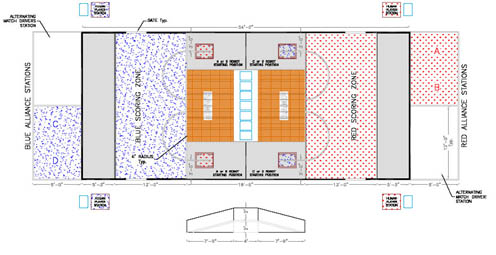2003 Game - Stack Attack
The 2003 Playing Field

This year’s playing field is 24 feet wide by 54 feet long. It is enclosed on its long sides by a pipe railing that is 20 inches high. The end sections consist of four "Driver Stations" that are located behind 36-inch high aluminum diamond plate walls with 48-inch acrylic safety view panels on top. A four-foot wide by 12-foot long by two-foot high plastic-surfaced platform is located in the center of the field. Access to the platform is provided by 12-foot wide, welded steel wire mesh surfaced ramps on each of the long sides. These ramps are eight feet in length and are set at approximately 14 degrees from horizontal. Two-foot high sheet plastic walls protect the open sides of the ramps and platform. At each side of the platform is a six-foot wide alley that connects the opposite ends of the playing field. These alleys are divided at midfield by a pipe rail. The surface of the playing field is carpet. The carpet will be marked to allow for the use of optical sensor tracking and navigation. The human player containers will have reflective tape on them for sensor tracking.
The 2003 Game – Stack Attack
The object of the game is to collect and stack plastic storage containers on your alliance's side of the playing field, or "Scoring Zone." Each match is two minutes long, and features two alliances, red and blue, each trying to collect and stack the most plastic containers. Each alliance is composed of two teams, to make a total of four robots playing on the field.
The location of the containers and the height of each stack determines each alliance's score for every match. The match starts out with 29 containers stacked in a pyramid across the center platform. Before the match begins, one human player from each alliance is allowed to stack an additional eight containers anywhere on the playing field. The four robots start in their respective zones (red or blue), on either side of the center platform.
The match begins with a 15-second Autonomous Period, wherein the robots function only according to pre-programmed instructions and/or sensor inputs. The robots attempt to collect container stacks, maneuver them, or knock down their opponent's stacks, all without human control of any kind.
After the Autonomous Period, the robots are under complete control of the drives for the remainder of the match. The final score is the result of multiplying the number of containers in the highest stack by the total number of legal containers in your alliance’s scoring zone. An additional 25 points is awarded for a robot that is positioned on the top of the center platform.
